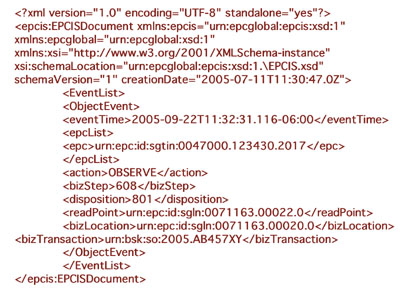Target and Wal-Mart, two of the largest retailers in the United States, are sharing Electronic Product Code (EPC) data with 13 manufacturers as part of a pilot. The data is being transmitted in a standardized format via an Internet-based electronic data interchange called applicability statement 2 (AS2). The manufacturers have requested anonymity, but they include some of the largest consumer packaged goods (CPG) manufacturers supplying Wal-Mart and Target.
The pilot represents a major advance toward the goal of using EPC data to track goods throughout the entire supply chain, as it gives manufacturers a way to benefit from the tags they put on pallets and cases for their retail customers. The agreed-upon data formats include data elements that explain where a tag was read, what business process it was part of and the status of the product (available for sale, for instance). As such, the suppliers can gain insights into not only their products’ location within the retailers’ operations, but also their status. This knowledge will help the manufacturers improve their level of service to the retailers, while also increasing product availability to consumers.

“This data-exchange pilot is a huge tipping point,” says Raymond Blanchard, a member of EPCglobal‘s Data-Exchange Working Group and cofounder of TrueDemand Software. TrueDemand has developed applications that can take advantage of EPC data and enable several of the business cases created by the EPCglobal Business Action Group. “Suppliers have been complaining about the data they are getting back, and Wal-Mart and Target stepped up to the plate and said, ‘Let’s figure out the use cases, and we’ll share the data with you.'”
Target and Wal-Mart had previously been providing the data in different formats. The manufacturers had to manually log on to Retail Link and Partners Online, the extranets run by Wal-Mart and Target, respectively, to download the data into an Excel spreadsheet. The suppliers, however, have struggled to make sense of the EPC reads so they could be automatically used to enable business applications.
Until now, that is.
“Having a standardized data structure is a foundational step needed to share information over the EPCglobal Network,” says Mike Meranda, president of EPCglobal US. “This proof-of-concept pilot is a way to test the format that Wal-Mart, Target and the manufacturers have come up with.”
The pilot will help the Data-Exchange Working Group determine whether the agreed-upon formats work in the real world. The live exchange of data might reveal that more data elements are needed, or that the current attributes need to be changed. The data structures might eventually be incorporated into the standards for the EPCglobal Network, a means of exchanging data associated with EPCs over an Internet-based network hosted by EPCglobal.
Meranda says that standardized data structures will lower the cost of sharing data for manufacturers. “The less time you have to spend aligning data with your trading partners, the less expensive it is to implement a network-connectivity relationship with someone else,” he says. Today, it costs companies thousands of dollars per month to do electronic data interchange over value-added networks.
About a year ago, EPCglobal’s Fast-Moving Consumer Goods Business Action Group, which includes Target, Wal-Mart and several major CPG manufacturers, established a Data Exchange Working Group to create the business cases and processes that could be improved by sharing EPC data. The working group began examining how retailers and manufacturers could enable the automatic communication of EPC data.
The members defined and examined all the potential cases, such as new product introduction management, promotion management and store replenishment, where RFID data might be useful. They then created some 50 data elements that could be associated with an EPC, including the business step associated with the read (shipping, receiving and so on); the location of the reader (manufacturer’s distribution center, retailer’s distribution center, back of store); the status of the product (available for sale, damaged, being returned); and so forth. Finally, they developed the XML tags and schema—coding that software applications can use to process and communicate those elements automatically, in a standardized way.
The Fast-Moving Consumer Goods EPCglobal Business Action Group agreed to the pilot, which just started, at a meeting in Atlanta last month. For the first phase, the retailers are transmitting the data to the manufacturers in the agreed-upon format over the AS2 system. The next phase, slated for early next year, will test applications that take advantage of the data. Once EPCglobal finalizes the standards for the EPC Information Service, the manufacturers and retailers will test the ability to share data over the EPCglobal Network.
“This is elemental data—the EPC, plus time, date, location and so on—structured so it’s understood by a trading partner,” says Meranda. “Getting the data structure right is the first step toward being able to answer the more complicated questions that the EPCglobal Network will help with.”

